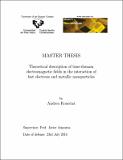Por favor, use este identificador para citar o enlazar a este item:
http://hdl.handle.net/10261/246823COMPARTIR / EXPORTAR:
 SHARE
BASE SHARE
BASE
|
|
| Visualizar otros formatos: MARC | Dublin Core | RDF | ORE | MODS | METS | DIDL | DATACITE | |

| Título: | Theoretical description of time-domain electromagnetic fields in the interaction of fast electrons and metallic nanoparticles |
Autor: | Konečná, Andrea CSIC ORCID | Director: | Aizpurua, Javier CSIC ORCID | Fecha de publicación: | 2014 | Editor: | Universidad del País Vasco | Resumen: | In this master thesis we dealt with the theoretical description of the fields inside and outside of a small metallic sphere influenced by fast electron passing by its close proximity and therefore producing external disturbance. This problem is very important for the fundamental understanding of many interesting phenomena, since an ambiguous behaviour of the nanoparticle has been predicted. The particle can experience both attraction and repulsion with respect to electron beam, depending on impact parameter. First we briefly introduced the theory of the electromagnetic field and the formalism used to describe the spectra in electron energy loss spectroscopy, which is closely related to our problem. We also described three basic numerical approaches that are commonly used, when we need to solve the problem of electron energy loss. Our main interest is focused on the boundary element method, which was utilized for comparison with analytical results in following chapters. Then we continued with previously developed approaches leading to analytical expressions of the fields outside the sphere exploiting multipole expansion and showed, how the fields look like in frequency domain. We compared calculated EEL spectra and the fields with numerical results obtained from the boundary element method. In the main part of the thesis we transformed the fields from frequency to time domain as we wanted to reveal, what is happening in real time when the electron passes near the particle, and discussed the results for two different time scales – attoseconds and femtoseconds. Attoseconds correspond to times of the closest approach of electron to the particle, which can feel large external fields. However, at this time scale particle is not able to respond and the induced fields are very small. On the contrary, in the femtosecond regime localized surface plasmon oscillations are generated as a response to external fields that were acting on the particle in attoseconds. During these times, the electron is very far from the particle, but the induced fields are quite large. The last section was devoted to calculations of the mechanical force acting on the particle as we wanted to find out the reason why the particle sometimes experiences attraction and sometimes repulsion. We were dealing with this problem again in attoseconds and then in femtoseconds. We performed the surface integration of Maxwell stress tensor, which represents the time derivative of the total momentum. However, we showed that this is not equal to the mechanical force, which can be obtained by subtraction of the field momentum time derivative. As these calculations are very computationally demanding, we were able to calculate the pure mechanical force for time (t = 0 as). What seems crucial for future calculations, is not only the emphasized subtraction of field momentum time derivative to obtain the force causing the nanoparticle movement, but also the testing of convergence for increasing nmax, more points where the fields are calculated and more sophisticated models for dielectric functions characterizing the response of the particle. We should also think about the validity of our approach which does not take nonlocality into account or treats the electron as a localized particle. | Descripción: | Master's in Nanoscience. | URI: | http://hdl.handle.net/10261/246823 |
| Aparece en las colecciones: | (CFM) Tesis |
Ficheros en este ítem:
| Fichero | Descripción | Tamaño | Formato | |
|---|---|---|---|---|
| theorinanopa.pdf | 2,46 MB | Adobe PDF |  Visualizar/Abrir |
CORE Recommender
Page view(s)
71
checked on 23-abr-2024
Download(s)
161
checked on 23-abr-2024
Google ScholarTM
Check
NOTA: Los ítems de Digital.CSIC están protegidos por copyright, con todos los derechos reservados, a menos que se indique lo contrario.
